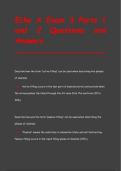Tentamen (uitwerkingen)
Echo A Exam 3 Parts 1 and 2 Questions and Answers
- Vak
- Instelling
Describe how the term "active filling" can be used when describing the phases of diastole. Ans- Active filling occurs in the last part of diastole (atrial contraction) when the atrium pushes the blood through the AV valve Into The ventricle (25 to 30%). Describe how was the term "passive fi...
[Meer zien]




